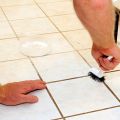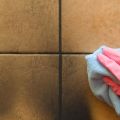2/24/2020
How to Clean Badly Stained Grout in the Bathroom or Kitchen

8/19/2022
Grout cleaning is not fun and this bright white stuff shows every a bit of a blemish. It is not hard to get tiles clean and gleaming, but it is more difficult to clean the grout between them.
Got a badly stained grout in your bathroom or kitchen? Don't fret, the following tile and grout cleaning tips will make your least favorite household duty a bit easier.
Got a badly stained grout in your bathroom or kitchen? Don't fret, the following tile and grout cleaning tips will make your least favorite household duty a bit easier.
Types of Grout
Before cleaning, it is essential to understand the various varieties of grout. The grout has several varieties, the majority of which are available in different colors. Before collecting cleaning products and developing a cleaning strategy, it is essential to consider both kind and color. The two most common type of grout nowadays are:
- classic cement grout
- modern standard, epoxy grout.
These grout kinds may be further classified as follows:
- Sanded Grout - Sanded grout is composed of cement and contains visible and palpable grit. In joints wider than 1/8 inch and up to 5/8 inch or 1 inch, depending on the product, tilers use sanded grout. It is a good option for frequently traveled flooring, but not for polished, smooth stone. Why? During grout application, the grit might scratch these surfaces.
- Unsanded Grout - Unsanded grout is also composed of cement, but it lacks grit. For gaps as tiny as 1/16 inch wide, tilers use unsanded grout. This resilient substance is simpler to work with and clean than sanded grout, and it is suitable for both polished stones and vertical surfaces such as shower walls. Unsanded grout feels more tacky and seems somewhat smoother than sanded grout.
- Epoxy Grout - This type of grout is more resistant to water stains and shrinkage than cement grouts. Epoxy grout absorbs up to 50 times less water than cement grout, and it is stronger. It performs well in tough situations, such as kitchen backsplashes and shower surrounds. It is also simpler to clean and more likely to recover to its original color than cement grouts, which is a significant benefit if you are tiling with white or another light grout color. Epoxy grout is even less susceptible to cracking. However, it is more costly than cementitious material and takes longer to apply.
Stained Grout in the Bathroom or Kitchen Cleaning Tips
1. Warm Water and a Nylon Brush
At certain times, a little amount of water and elbow lubricant is all you need. Doing simple spraying of some warm water onto the grout, then scrub it with a stiff-bristled brush using a circular motion. This might be enough to keep away light surface dirt and reveal the white grout beneath.2. Water and Vinergar Solution
For mildew stains, you may use a water and vinegar combination. Spray this solution into the soiled spots, wait 5 minutes, and then scrub it off with a stiff-bristled brush. If required, rinse the affected area with warm water. On stubborn stains, you may also use a paste prepared from baking soda and water. Mix baking soda with sufficient water to produce a thick paste. Spread this mixture on the afflicted region and scrub it with a stiff-bristled brush, then rinse with warm water.
3. Hydrogen Peroxide
Use hydrogen peroxide on tough stains. Spray hydrogen peroxide vertically over the affected area, or create a paste from baking soda. Wait several minutes after applying the hydrogen peroxide to the grout before scrubbing it with a stiff-bristled brush. When you are almost finished, rinse the area with water.4. Oxygen Peroxide
Use store-bought "oxygen bleach" cleansers. Look for products that claim they will work on grout or that include "oxygen bleach" Open the bathroom fan or a window, and put on rubber gloves. Use the product as instructed. Most solutions need you to sit on the grout for 10 to 15 minutes, after which you must clean it with a stiff-bristled brush. When the time is over, rinse the cleanser off with warm water.Steam-Clean
Steam-clean the worst grout stains returning it to its original white color. The finest steam mops are efficient and eco-friendly cleaning equipment for grout cleaning and other hard surfaces around the home.Bleach Dilluted with Water
For severe and extreme situations, dilute bleach with water. Bleach is a toxic substance; keep the bathroom fan running or open a window. Don't forget to wear a pair of rubber gloves, safety goggles, and some old clothes. Additionally, fill a spray bottle with 1 part bleach and 10 parts water. Spray the solution into the grimy grout, then wait about two minutes. Scrub the area with a stiff-bristled brush before rinsing with water.Baking Soda and Bleach Paste
Have baking soda and bleach paste on hand for extreme grout cases. Create a thick paste by combining 2 parts baking soda with 1 part bleach. Spread this paste over the filthy grout and wait 5 to 10 minutes. Scrub the grout with a stiff-bristled brush, then wait a further 5 to 10 minutes. When finished, remove the paste with water.Most Trusted Tile & Grout Cleaning Provider in Naples, FL
Knowing how to clean dirty grout improves the look and extends the life of your tiles. Trust your tile and grout cleaning with DG Cleaning and Carpet Care, LLC, your professional Tile and Grout Cleaning Company in Southwest Florida.
DG Cleaning and Carpet Care, LLC specializes in a variety of services including:
- Residential and Commercial Carpet Cleaning
- Emergency Water Damage Drying and Cleaning
- Pressure Washing
- Tile & Grout Cleaning
- Upholstery Cleaning
- House Cleaning
- Mold Removal
Contact DG Cleaning and Carpet Care LLC at 239-438-4703 today and we will be on our way to taking proper care of your property!
Other articles and publications:
Trust your tile and grout cleaning to an executive professional cleaning company- DG Cleaning and Carpet Care, LLC, your Tile and Grout Cleaning Company in Florida.
The coronavirus crisis is not abating anytime soon. We can only protect ourselves as much as we can by being consistently hygienic and be aware of how we can kill this virus the safest way possible.
5/11/2020
We always advise our clients to rather prevent than cure issues. Regular care for your tiles and grouting lines will also make your home more hygienic and improve the indoor air quality.
8/13/2019
Clean and nice smelling carpets always make a good impression, so make sure you always upkeep your carpet. Regular carpet cleaning is an essential routine in the maintenance of residential property.
1/7/2020
Keeping your home clean is vital, and taking care of upholstery is an important part of that. For the best results, our trained technicians can recommend the most suitable method for any fabric.
10/9/2019
Try some homemade DIY carpet cleaning techniques. Call DG Cleaning and Carpet at 239-438-4703 if you need professional carpet cleaners.
7/16/2021
Articles and publications of other companies:
It is important for everybody to clean and disinfect to reduce the spread of viruses, but it is also important to do it properly. Learn more.
7/14/2020
A professional sanitizing service can help you thoroughly clean your bathroom. However, you may also need to clean your bathroom yourself, so we’ve prepared a few tips on how to do it.
9/9/2020
How can you determine which cleaning company is right for you? The experts at ServiceMaster by PWF listed the few essential qualities of a professional commercial cleaning company
12/16/2020
The CDC’s guidelines call for every home and business is to clean and disinfect all areas. Call ServiceMaster by Pinellas if you want your premises cleaned to reduce the threat of COVID-19.
6/19/2020
The kitchen is where the magic happens. Kitchen surfaces can not only harbor the bacteria we transfer from our hands and belongings but also food-borne bacteria, so it’s important to disinfect items.
9/9/2020
Many factors affect the water damage mitigation process, such as the level of contamination. Learn more in this article by ServiceMaster by Wright.
4/22/2021
Business details
- +1 (239) 438-4703
- 2614 Tamiami Trail N, Naples, FL 34103, USA
- www.dgcleaningandcarpetcare.com/
We specialize in a variety of services including residential and commercial carpet cleaning, emergency water damage drying and cleaning services, grout and tile cleaning, house cleaning.






